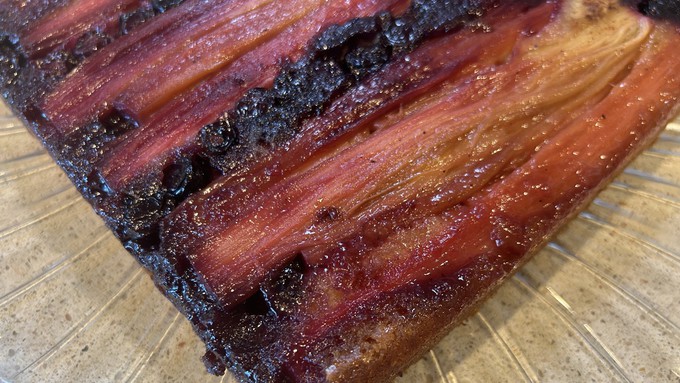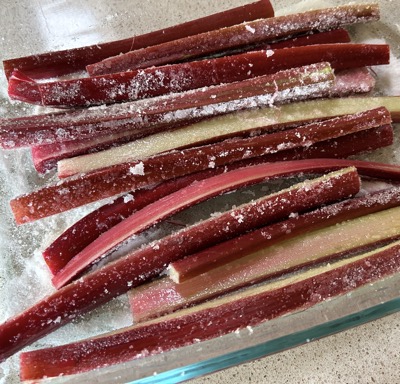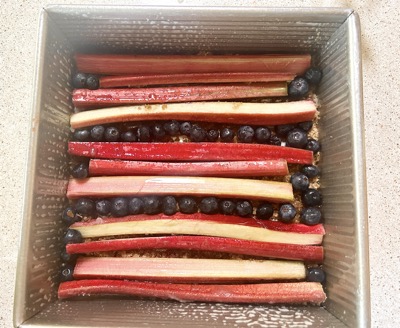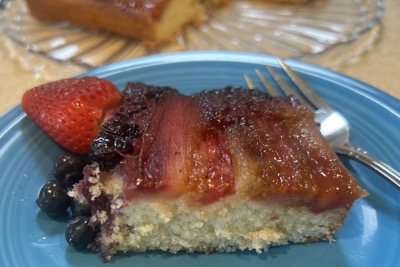
Recipe: Upside-down cake features stripes of rhubarb, dots of blueberries

Rhubarb stripes are accented with blueberries on top of this easy spring cake. Kathy Morrison
Rhubarb doesn't grow well around Sacramento. It prefers cooler weather and wet conditions. I have one small plant in a large pot that I keep more for curiosity than anything else. So when the red stalks finally show up at the store or at a farmers market, I snap some up.

This recipe resulted from my desire to bake something with rhubarb that wasn't pie. Digging through cake recipes for ideas, I noticed that bakers complained about the rhubarb sinking into the cake batter when placed on top. And one recipe gave me a great tip: Macerate the rhubarb first before baking, to soften and sweeten the extremely tart stalks.
My result: An upside-down cake that uses the macerated rhubarb, alternating with blueberries just because I like blueberries. Stripes and dots upside-down cake! But go with all rhubarb if you like. Or substitute raspberries or blackberries for the "dots."
(What about strawberries? Uh, no. They turn an unappetizing color when baked like this. Serve them on the side.)
This cake can be a brunch treat or a dessert, served plain, with whipped cream or vanilla ice cream.
Rhub-berry upside-down cake
9 servings
Ingredients:
For the fruit layer:

1/2 pound rhubarb stalks (about 4 or 5, depending on thickness)
1/4 cup granulated sugar
2 tablespoons unsalted butter
1/4 cup light or dark brown sugar, packed
1/4 teaspoon nutmeg or other favorite baking spice
1/2 cup blueberries, washed and destemmed, optional
For the cake:
1/4 cup softened unsalted butter
1/2 cup granulated sugar
1/2 teaspoon lemon zest
1 egg
1 cup unbleached all-purpose flour
1 teaspoon baking powder
1/4 teaspoon salt
1/8 teaspoon (or more) nutmeg or favorite baking spice
3/8 cup milk
1 teaspoon vanilla extract
Instructions:
Measure the rhubarb stalks against an 8-by-8-inch baking pan and trim them so they will fit inside the pan. Then slice the trimmed stalks lengthwise, into two or three pieces, so they all are about the same thickness.
Place the rhubarb stalks in a separate flat dish or pan, and sprinkle the 1/4 cup granulated sugar over them. Stir lightly so the stalks are covered with sugar. Set this dish aside for 20 to 30 minutes; the rhubarb will start to macerate and get jammy.
Meanwhile, heat the oven to 350 degrees. Place the 2 tablespoons butter in the 8-by-8 pan, and put the pan in the oven just long enough to melt the butter.

Remove the pan from the oven, aand rock it around so the butter evenly coats the bottom of the pan. Sprinkle the brown sugar and 1/4 teaspoon nutmeg (or other spice) evenly over the melted butter. Spray the interior sides of the pan with oil spray, or rub a little more butter around the sides. This is to ensure the upside-down cake comes out cleanly. Set the pan aside while you make the cake batter.
In a medium bowl, cream the softened butter with the 1/2 cup granulated sugar and lemon zest until smooth and light. Add the egg and stir until combined.
In a small bowl, whisk together the flour, baking powder and salt. Pour the milk into a glass measuring cup and stir in the vanilla extract.
Alternately add half the flour mixture and half the milk to the batter, beating well after each addition, then add the rest of the flour and finish with the rest of the milk.
Now, arrange the rhubarb stalks and the berries (if using) in one layer on top of the butter and brown sugar in the 8-by-8 pan. The fruit should cover the sugar but not be crowded.
Spread the cake batter evenly over the fruit.

Bake the cake 30 to 35 minutes until golden brown; you may see some fruit bubbling in the corners. Remove the pan to a cooling rack for 5 minutes. (The cake may be too cool to flip if it sits longer.)
After 5 minutes, run a knife around the edge of the cake. Place a serving plate on top of the cake pan, and carefully flip it and the pan over together so that the cake unmolds onto the plate. Any fruit that sticks to the pan can be gently removed and replaced on the cake.
Serve cake warm or at room temperature, with berries, whipped cream or ice cream.
Note: I had some leftover rhubarb, so I cut it up and added it to the sugary remains of the macerating step, saving it for another baking project.
Comments
0 comments have been posted.Sacramento Digs Gardening to your inbox.
Sites We Like
Garden Checklist for week of July 21
Your garden needs you!
* Keep your vegetable garden watered, mulched and weeded. Water before 8 a.m. to reduce the chance of fungal infection and to conserve moisture.
* Feed vegetable plants bone meal, rock phosphate or other fertilizers high in phosphate to stimulate more blooms and fruiting. (But wait until daily high temperatures drop out of the 100s.)
* Don’t let tomatoes wilt or dry out completely. Give tomatoes a deep watering two to three times a week.
* Harvest vegetables promptly to encourage plants to produce more. Squash especially tends to grow rapidly in hot weather. Keep an eye on zucchini.
* Pinch back chrysanthemums for bushy plants and more flowers in September.
* Remove spent flowers from roses, daylilies and other bloomers as they finish flowering.
* Pinch off blooms from basil so the plant will grow more leaves.
* Cut back lavender after flowering to promote a second bloom.
* It's not too late to add a splash of color. Plant petunias, snapdragons, zinnias and marigolds.
* From seed, plant corn, pumpkins, radishes, winter squash and sunflowers.